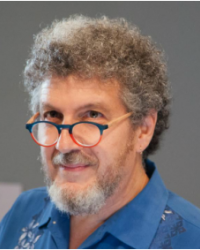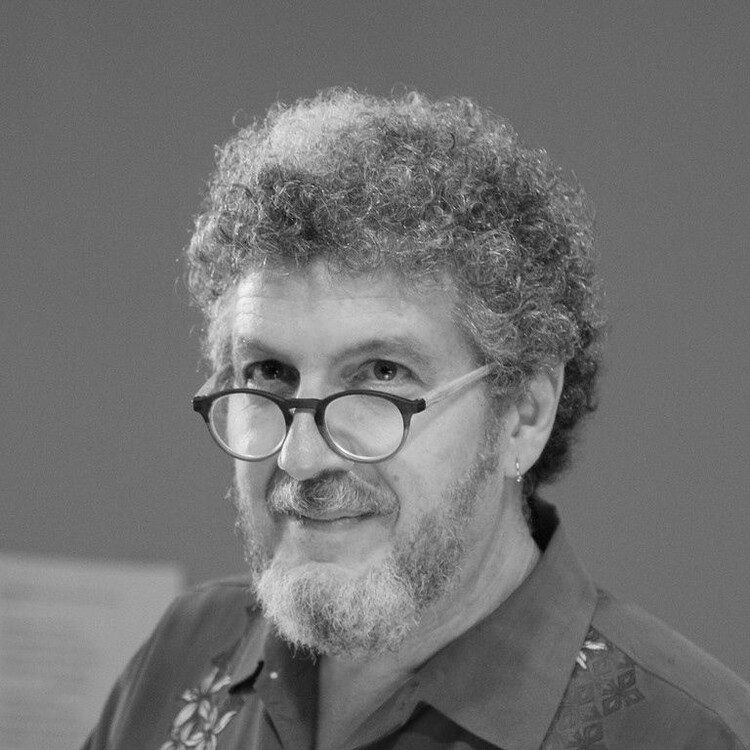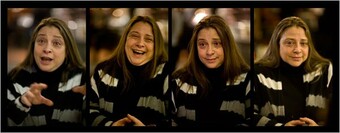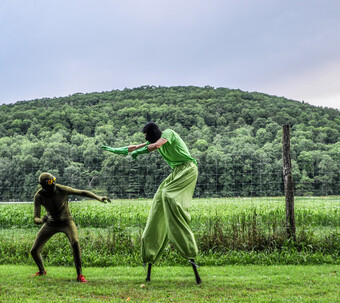One for All and All for One and Every Man for Himself
This keynote address was given at the NoPassport Conference in New York City, March 1st 2013.
I take my title today from that great triumvirate of American philosophers: Moe, Larry, and Curly, known in poststructuralist circles as Les Trois Stooges. With unerring precision they captured the complicated essence of American life—and by extension American theatrical life—in their expert revision of the motto of Alexandre Dumas’ three Musketeers: “One for all and all for one.” To which the incisive Curly added, “And every man for himself.” Yes that’s my subject, the one and the all, for each other and for themselves. In the spirit of the Stooges, I will digress whenever possible, including now, before I get to the point.
I’m not sure how to talk about my subject, in part because I don’t know what language to use. I’ve lost track of the language of our art. After seventeen years of running a nonprofit, it’s been replaced by the lingo of strategic planning and program assessment. It’s been trumped by meaning-deplete, market-aping clichés of our professional shoptalk—branding, innovation, entrepreneurial—and by the hollow repetitions of grant-speak that have sucked the specificity out of such essentials as, “community,” “vision,” “values.”
Somewhere, maybe, lives a root language of theatre for us to speak with one another. Somewhere, maybe, is a tongue with words for what we do, how it lands on the human spirit, how we share space and time, story, myth, intention, and feeling. Somewhere there’s an idiom of our being together—a dialect of presence. I wish we could pledge allegiance to an ever-new coinage: the shaky, groping, overheated, imprecise, exuberant, vulnerable, earnest diction of mid-discovery.
I’ve spent part of the past ten years revisiting, collecting, and editing the words of the American theatre’s fanatical founders—in search of original language. Fanatics like the Group Theatre’s Harold Clurman, for one, and Susan Glaspell of the Provincetown Players, W.E.B. Du Bois, Hallie Flanagan, Margo Jones, Zelda Fichandler, Luis Valdez, Charles Ludlam, Douglas Turner Ward, Herbert Blau—they write in impassioned, heart-pumping phrases that help me get through the day by cutting through the accumulated noise of a half-century of institutional and professional cant.
One phrase kept surfacing, as I prepared to write this. It’s from Julian Beck, who, as you may know, back in 1947, founded, with his wife Judith Malina, the still-living Living Theatre. Beck’s meditations read like rabbinical fire: fervent, philosophical, ecstatic. They burn for a truer theatre and, more importantly, a better world. Amidst the flames, there’s an almost throwaway statement; its simplicity has haunted me. 1962. New York City. Beck writes to himself: “I do not like the Broadway theatre, because it does not know how to say hello.”
Fifty years have passed since he wrote those words, sixty-six since the Becks started their theatre. The American theatre has in that time exploded—Off Broadway, Off-Off, regional theatre, alternative regional theatre, community-based theatre. The Living Theater’s experiments in poetry, politics, company, global activism have, likewise, exploded, and even those whose sole image of the Becks has them naked and chanting in the streets or against a massive, backlit scaffold demanding “Paradise Now” are, in some way, heirs to their experiments and ameliorative ambitions. We are all, I wish to believe, enemies of the kind of falseness Beck finds on Broadway, where, he claims,
The tone of voice is false, the mannerisms are false, the sex is false, ideal, the Hollywood world of perfection, the clean image, the well pressed clothes; the well scrubbed anus, odorless, inhuman, of the Hollywood actor, the Broadway star. And the terrible false dirt of Broadway, the lower depths in which the dirt is imitated, inaccurate.
I want to know how to say hello. I want our artists to know. Maybe that’s why I can’t get the phrase out of my head, why I repeat it to you today. I want to greet you from the deepest part of me and hear from the deepest in you. I want nothing less from our theatre. I want theatres to feel like rooms. I want what passes in them to engender intimacy, even if the performances are wild, flamboyant, artificial things. I want to speak in your ear and have you speak in mine. I want performance that feels like revelation. I want to be in it—whatever it may be—together. I want to know how to say hello.

Photo by University of Washington.
Specifically, I long for a language of individual distinction. Somewhere in the decline of critical attention, the rise of celebrity, and the homogenization of production, we’ve lost the knack for celebrating the specificities of talent. What makes one artist distinct from another? What are the unique gifts of this writer, that director, each actor? How can we point the way to those singularities in words—the way one writes or plays or moves from what one is, from the fullness of the available self? What is the “I” from whence the individual speaks to us, the something that novelist Marilynne Robinson calls “incandescence,” “that presence, shaped around ‘I’ like a flame on a wick, emanating itself….” How does what we receive from the world get translated through the artist’s unique perspective and imagination and, once translated, how does it, to use her great phrase, emanate itself? If art is, as a painter once said, “nature as seen through a temperament,” how can we, as collaborators, teachers, co-citizens, nourish artistic temperament and celebrate it?
I love this description by Elena Passarello, from her kick-ass book of essays about the voice, Let Me Clear My Throat. I love it for its brazen specificity. In “The Harpy,” Passarello describes the lead-up to becoming the first woman to ever win New Orleans’ Stella and Stanley Screaming Contest:
My scream moves through a body that has been in working order for over thirty-three years. It is a five-foot-six-and-one-half-inch female body, around 140 pounds, and its bone structure appears larger than those of most women I see in the park or at the gym or in the market. Only one of these larger-than-average bones—a metatarsal—has broken, but this still affects the body posture and thus, according to some, the resonance of the voice. I think, however, that the warped state of the neck and shoulders after years in front of a laptop alters the sound much more significantly. Twenty-five and a half percent of this body is fat and up to sixty percent of it is water. It is not without its tonsils or its appendix and it has never been impregnated. All these things are a part of the sound you hear when I sigh, sing, or say “hello,” or scream it.
How can we attend to each other’s gifts with this kind of specificity? How can we listen for the peculiar gifts of diction, the evolution of concern across bodies of work, the balance of hesitation and attack that marks one’s approach to the world? How do we make a theatre, a world that gives the individual his or her fullest stature?
According to the voluble Harold Clurman, who talked into being the seminal Group Theatre of the 1930s, it’s only in the company of others that the individual can reach full flower. Clurman writes of the Group: “We believe that the individual can achieve his fullest stature only through the identification of his own good with the good of his group, a group which he must help to create.” Is this true: the individual reaches fullest stature only by tying his own good to that of the group? Doesn’t the individual gain stature from the spotlight, from having us stare at him until, in our eyes, he grows huge, even mythic?
This is really what I want to address here: the individual and the group, the “I” and the “we” of the theatre. How we fulfill ourselves. How we greet one another, treat one another. How hard it is to reconcile one and all. My themes are lifted from Clurman: The individual. Fullest stature. Identification of personal good with group good. The group each must help create.
This is really what I want to address here: the individual and the group, the “I” and the “we” of the theatre. How we fulfill ourselves. How we greet one another, treat one another. How hard it is to reconcile one and all.
My greatest personal excitements in the theatre happen in apparently contrary contexts. On one hand, there is the often private, fiercely individualized playwrights laboratory at New Dramatists, where I work. In that lab I’ve had my mind blown by writers’ imaginations, by their output, by the combustion or maturation of their voices. I’ve been thrilled by their acts of illumination. On the other hand, there may be nothing more electric in the theatre than the collective, crazy, creative furor of an ensemble. It’s not for nothing that institutional theatres and critics and funders are looking to ensembles to reinvigorate our field.
How do we reconcile these separate excitements, these seemingly distinct realms: the independent, maybe even solitary creator—or actor, director, designer—and the genius of the group? It’s a tough one. I spend my days advocating and making space for independent artists, even as I long for company. Artistic freedom and individual voice on one side, inspiring collaboration and common good on the other. The struggle to reconcile the ambitions of “I” and “we” has plagued the American theatre for a hundred years. This tension between individual and group is, I believe, a defining challenge of our theatre, probably our culture. All for one and one for all or every man for himself? The Three Stooges agree.
The fusion of individual talent and collective energy fuels great theatre. It has always been so. The history of dramatic literature is inseparable from the history of the acting company: Shakespeare and the King’s Men, the Troupe de Molière, Sheridan’s Drury Lane, Chekhov and the Moscow Art Theatre, Brecht, Churchill, Walcott, Fugard—and on and on—fresh theatrical language forged where playwrights and players adventure together. Look at seminal twentieth-century directors and the case is just as clear—Strehler, Mnouchkine, Brook, Littlewood, Barba, Suzuki, LeCompte—all create in the context of company. New performance and methods of performance almost always rise from the individual and the group adventuring together.
The fusion of individual talent and collective energy fuels great theatre. We know this. But still, in America, it’s nearly impossible to sustain their communion. The original Provincetown Players, circa 1915, a marriage of Eugene O’Neill’s capacious talents, the oracular energy of George Cram Cook, and a constellation of the leading artistic/intellectual/political lights from America’s first Bohemia, lasted only a few years. The Group Theatre—which spawned every major acting school of mid-century America—Strasberg, Adler, Lewis, Meisner—great directors Clurman and Kazan, and the seminal voice of Clifford Odets—struggled against the pull of Hollywood and the endless difficulties of negotiating individual agency and collective leadership before folding at age ten. The Open Theater, Second City, the Steppenwolves, the Woosters—name a major gathering of theatre talent—that pivotal coming together of solo and group gifts that defines a moment, these genius scenes or what Brian Eno dubbed “scenius”—name one such theatre scenius that hasn’t been battered by a) economics that lead underfunded individuals to more lucrative careers, b) a national character that values individual power over group connection, and c) the physics of centrifugal spread and entropy. Some groups dissolve, some morph and flourish, some keep on keeping on with what novelist Stanley Elkin brilliantly calls, “the persistence of the obsolete.”
There are two ways, history also tells us, to sustain a theatre in the United States: the first way is to institutionalize, to establish an organization that is viewed as essential to the community or place in which it grows, and to maintain that entity, even beyond the career-span of the people who initially give it life. The second way to sustain a theatre here, the harder way, is to balance the evolving needs of the individual artist—voice and ambition—with the evolving group genius, to balance the needs of self-determination and those of the common good. This is the harder way.
In institutional life, human beings are for the most part replaceable; they serve, necessarily and rightly, institutional identity. In company or group culture, each member must be reckoned with, must be given their lead. Care and feeding, of individual and company, goes both ways. If this second approach—that which holds the individual and the group in equitable esteem—were easy, the history of our theatre wouldn’t be strewn with the corpses of ensembles and company-founded theatres.
The story of our most recent theatre—of the past thirty years or so—is often told as a history of domination by institutional theatres. This is the critique that has defined so many of us—myself included. But I’m here to tell you that this is not the story. The story is a story of revolution, quiet, sustained, many-headed. It’s a story of the rise of democratic practices, the exploration and elaboration of methods of participation and shared leadership. It’s a history of experiment, not of form but of process—practice and process—how we collaborate and care for one another, how we interact with community. It’s a story of relationships—between individual and group, inside and outside the theatre. You may already know this story, but let me tell you again.
First you have to know the cast of characters: We know the names of the American theatre’s over-looming institutions, but do we follow with equal intensity the careers of the long-lived process revolutionaries? After Provincetown and the Group and the Living Theatre and Free Southern in Jim Crow Mississippi, the San Francisco Mime Troupe, and El Teatro Campesino came Junebug, Roadside, Pregones, Dell’Arte, Bloomsburg, Cornerstone, Double Edge, and after them came San Francisco’s Intersection for the Arts, Minneapolis’s Ten Thousand Things and Pillsbury House, Theater Offensive in Boston, and too many to name.
I experienced an epiphany last summer, the sort I considered myself well past. I grew up in Chicago, before the Off-Loop theatre boom there, and have stayed fixated, with a kind of exile’s fascination, on that city’s theatrical doings. In 1990, after dozens of interviews and months of research, I wrote for American Theatre magazine what I felt was a definitive, seminal, never-to-be surpassed history of that city’s theatre, its roots in improvisation and oral interpretation, its major artists and its then-all-too-evident maturity—Robert Falls at the Goodman, Frank Galati everywhere, Steppenwolf doing Steinbeck on Broadway. In 2011, I reprised my consummate summation with a keynote at the first ever Chicago Theater Symposium.
Then. Last summer. Northwestern University Press asked me to review a book it’s considering for publication, entitled Beyond Steppenwolf: Chicago’s Established Alternative Theaters, edited by two recent PhDs, also practitioners, Jennifer Schlueter and Erica Milkovich. I was skeptical. C’mon, I scoffed, beyond Steppenwolf are Steppenwolf wannabes. If these oxymoronic, so-called “established alternatives” exist, why don’t I, Todd London, of all outside experts, know more about them. It seemed like the usual example of carving out academic territory, elevating the insignificant to a stature it hasn’t earned, either out of personal connection or the urgings of tenure.
I was skeptical and then I was surprised. I read about theatres I knew a little—Redmoon, the Neo-Futurists, Prop Thtr—and about theatres I’d only or never heard of: The Annoyance, Curious Theatre Branch, Theater Oobleck, Plasticene Physical Theater, 500 Clown. I read about these theatres—twenty-five years old, riding the line between amateur and pro, working with incestuous, fluid, conscientiously collective structures unimaginable in more institutional contexts, experimental in aesthetic and interactivity—working fast like the Neo-Futurists or slow like Dexter Bullard and the Plasticene folks, working inside and outside of conventional theatre spaces like the fantastic Redmoon, passing talent back and forth like games-mother Viola Spolin’s imaginary ball way back at the beginning of Chicago’s postwar improvisational theatre nativity. Light bulbs popped. Here it was, before my very eyes for a quarter of a century and unseen in the shadow of the Goodman and Steppenwolf and Mayor Daley II’s building boom and all the fine mainstream and ensemble strivers who emulated Goodman and Steppenwolf. Here it was before my eyes—an unseen scenius.
What else, where else, wasn’t I seeing what was hiding in plain sight? I could click my way through a collection of similarly aged, similarly spirited companies in the Bay Area, in the Twin Cities. I’m at work, through New Dramatists with the nutty collection of individual/ensemble talent and alternative structure in Austin—the Rude Mechanicals, Salvage Vanguard, Physical Plant, Rubber Rep, and Trouble Puppet. What about Washington? Boston? Seattle? Atlanta? Iowa City? Baltimore, Louisville? What is happening and either not seen or not collected together and, so, seen whole? Even in this city, New York City, where I live—all those differently configured collectivities: the Civilians, Elevator Repair Service, Universes, Nature Theatre of Oklahoma, RadioHole, Richard Maxwell’s New York City Players, Labyrinth, the Debate Society, the now-imploded 13P—these are not young companies, anymore than Philly’s Pig Iron or New Paradise Laboratories are.
Established and alternative. It wasn’t just an epiphany; it was a geography, a new map.
I know it seems like I’m talking about proliferation—and to an extent I am—but that’s not the point. Yes, the undergrowth has become the field, but the transformation is deeper. The revolutionary change is one of process, how a whole generation of theatres—many now in advanced stride—have miraculously negotiated the hundred-year battle to reconcile individual and company.
And let me be clear—as someone devoted to playwrights and the art of soloist: This is not a revolution of “devised work,” one of the great misnomers of the contemporary theatre. This is a fusion revolution: the making of companies that call forth the unique strengths of their members.
The aesthetics are a smorgasbord of difference. Many of these companies work with playwrights, sometimes a single one, sometimes several at the same time. Some of them storyboard their creations. Some make two-minute plays. Some improvise. Some write in pairs or teams. Some are led by author-directors. Some use documentary techniques and verbatim dialogue; others draw on community story circles and invent the text. Many of them conscientiously walk the line between amateur love sport and professional commitment. New ways of making work, new meetings of individual talent and group ethos. And they aren’t young companies—they are fifteen and twenty and thirty-five years old. On the surface they share very little. Where it matters they share everything: they pursue—and have in many cases nabbed—the elusive grail of true merger, between individual and group agency, leadership, and, yes, vision.
Also known as democracy.
What exactly is this revolution of practice and process? Recently, as playwright/NoPassport publisher Caridad Svich and I were editing my new collection of old writing, I came upon a phrase I wrote twenty-five years ago: “The way we make theatre is as important as what we make.” In hindsight, I realize I didn’t know what I meant by that or how much a vague belief in this aphoristic truth would guide my life. Fortunately, there were folks out there who figured it out before me and knew what to do with what they knew. They knew that their methods and practices carried their human values, more than product or result. When I spoke to Mark Valdez, the ebullient executive director of the Network of Ensemble Theaters, he confirmed my epiphanic insight. Yes, the alternative is now the mainstream. Yes, they lead with their human values. And yes, in Mark Valdez’s words, “The process yields the aesthetics.”
True collaboration is not a means to an end, but an end in and of itself, a goal.
What are those aesthetics? What are the values worked out in practice? The ensemble theatres, through NET, have done a great job defining them: Collaboration; transparency in decision-making; inclusion and diversity; mutual respect. Ensembles stress flatness in decision making, where everybody brings ideas to the table, everyone’s ideas are valued. True collaboration is not a means to an end, but an end in and of itself, a goal. Human dealings inevitably play out on what Mark Valdez calls “a spectrum from consensus to hierarchy.” The process revolutionaries—committed to the quality of their interactions—spend more time at the consensus end. When things move inevitably toward hierarchy, they strive to keep those hierarchies clear and to increase participation in leadership.
As for inclusion and diversity, these are not concepts applied after the fact (or after the funding), they are the heart of the practice—of, literally, and figuratively taking everybody in. Take a tip from the apples: in art as in botany, monoculture leads to decline; biodiversity and cross-pollination are necessary for our survival. The same is true of a democratic art—and none is more democratic, in its bones, than theatre.
What to say about the fourth guidepost for process revolutionaries: mutual respect? My colleague Ben Krywosz, of Nautilus Music-Theater in St. Paul, kicks off his powerful two-week-long studio for Composers and Librettists by reading a story or maybe myth adapted from the introduction to M. Scott Peck’s A Different Drum. It’s a story I think about almost every day of my working life, and I’ll tell it to you now.
The tale centers on a religious order that has all but died out. Only five disciples remain in the “decaying monastery,” all over seventy years old. The community’s Father Abbot seeks advice from a rabbi who periodically takes hermitage in a nearby forest. He tells the rabbi of their struggle, and the wise man commiserates, “I know how it is…The spirit has gone out of the people.” They weep together. Before he leaves, the abbot again asks for advice, but the rabbi has none to offer. “The only thing I can tell you,” he says, “is that the Messiah is one of you.”
Of course the humble brothers and sisters don’t know what to make of this statement. How could one of them be the Messiah? Brother Thomas is a holy man but he doesn’t smile much. Sister Mary is just too crotchety, though she almost always proves to be right. Philip is “so passive, a real nobody.” Miraculously, though, he’s somehow always there when you need him. Maybe he is the Messiah. And so on. Finally the narrator gets to himself. “Of course the rabbi didn’t mean me…I’m just an ordinary person. Yet suppose he did? Suppose I am the Messiah? O please, God, not me!”
“As they contemplated this riddle,” the story continues, “the old people slowly began to treat each other with extraordinary respect, on the off chance that one among them might actually be the Messiah.” They find in each other the graces that may save them all. And just in case, “they began to treat themselves with extraordinary respect.”
In time, the old monastery, which people occasional visited on their wanderings through the woods draws more and more people. An aura of extraordinary respect seems to radiate out from the community. More visitors come. Some stay, including younger disciples. “And so it came to pass that within a few years, the monastery had once again become a thriving order and, thanks to the rabbi’s gift, a vibrant center of light and spirituality in the realm.” Four: Mutual respect.
None of these precepts, these intentions of one for all and all for one, negate the fifth: excellence. They do, though, it seems to me, recast our notion of excellence. They demand more of it, calling for excellence in our relations, as well as in our outcomes, a standard for our humanity in addition to that of our production. Yes, the way we make theatre is everything—our practice, our aesthetic, our relations, our gift to the world.
Of course, all theatres say they value collaboration, transparency, inclusion, respect and excellence. I’ve done my best today to avoid a critique of institutional culture in our theatre, because I want so desperately in my life to move past it. But here is where the double bind of empty language and the falseness or lack of candor among institutional theatre leaders make it tough. Yes, we are all good people; we’ve all gone into the theatre for the best of reasons; none of us is getting rich. But no, not all practices are built on these foundations. Jobbing in artists, short rehearsals, top-down administration, black history month diversity, chatting with a guest artist on the first day of rehearsal and again at the cast party, choosing the project or playwright the Times singled out last season—these are not the same as putting our methodology where our mouth is, believing that the way we work, the structures we create, the means to fulfilling our missions are as value laden, as important, as artistic, as what lands on our stages. The pursuit of quality theatre is not, in and of itself, the pursuit of a better world.
“A group which he must help to create”—that was Clurman’s dictum. And that should be the test. Not whether someone—actor, playwright, business manager—was present at the founding, but is that someone, in a daily way, in a true way helping to create the group. Does she have a voice? Is he present in his fullest stature?
I love Mark Valdez’s formulation: “The process yields the aesthetics.” The way we make work is not merely as important as what we make. It is what we make. You can see it—with individual artists, as in the work of the vital companies populating our current seen/unseen landscape. Process reveals itself through result. Improvised art feels improvised, shared creation feels cooperative, the monastic project emanates its own fanatical purity, aristocratic creation feels refined, and democratic art feels welcoming. The way we say hello carries who we are.
Where will our Messiahs come from? Who will they be? The student studying you from the back of the classroom? The intern answering your phones? The playwright who can’t yet find the sound of her own voice and, so, has began to perform her own work; the performer has just begun to write? Your old friends? You? How will they gather? How will they practice what they preach? How will they revitalize the old and reveal the new? Where are they now? Look around.









Comments
The article is just the start of the conversation—we want to know what you think about this subject, too! HowlRound is a space for knowledge-sharing, and we welcome spirited, thoughtful, and on-topic dialogue. Find our full comments policy here
I know I'm a little late to join the party, but yes, brilliant, thank you. Love to see more of this sort of thing on HowlRound.
Todd London, I do believe you just woke me up after what must have been a longer than 2 year sleep of surrender.
Wonderful. I am a company member of a small theatre based in Boulder, CO...we needed to read this! Thank you!
Blazing, magnificent, inspiring ... to me who is an independent concert artist. Thank you and congratulations!
Brilliant and illuminating....
Thank you Todd London for this attempt and these questions. It is true is difficult to talk about these subjects. But you had surpassed the hurdle superbly. I had been reading back and forth your article, thinking that I do have much to say, but I can't seem to be able to articulate it either. There is a need I believe to create forums, and spaces, such as Howlround, and or physical spaces where the building of relationships and the words can recuperate/reclaim their meaning. I think that inasmuch as we can repeat and consistently speak the way you Todd did here, we will have a good chance to transform the present history of domination into one of revolution; where the values you underline as the virtues of this model become more part of the general language, and less part of a hidden or forgotten story.
"An aura of extraordinary respect."
I humbly submit.
Thank you. Thank you. Thank you. Todd London, you could maybe possibly make me fall in love with theatre all over again.
Thank you for this! I've been exploring activating the individual inside a dynamic ensemble, and this keynote gave me more fuel right when I needed it. Thank you!
To read every day, for life. Thank you.
One of the best commentaries I've read on the past, present, and future of the American Theatre.
well said....